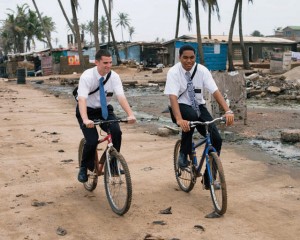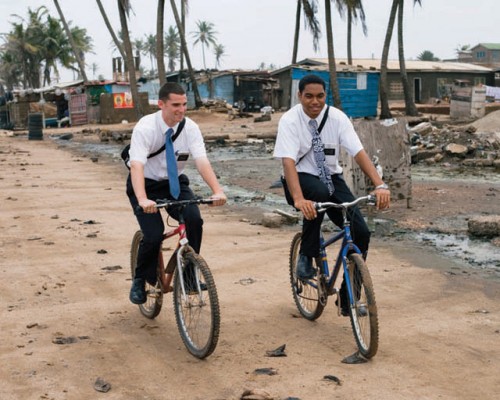The first Mormon missionary was undoubtedly Joseph Smith, the Prophet, who told his family and neighbors about his First Vision in which he saw Jesus Christ and God the Father. Though ostracized and harassed because of this, Joseph continued to assert the truth and on September 21, 1824, an angel appeared to him and called him to be a prophet. Joseph Smith’s first task was to translate the Book of Mormon from ancient engravings, which he did with the help of many scribes, including his wife, Emma Smith. In late March of 1830, the Book of Mormon was printed, and the early believers, including Joseph Smith, Martin Harris, Oliver Cowdery, the Smith family, and the Whitmer family began passing the copies around to each other and to family friends. On April 6, 1830, a couple dozen families gathered in Fayette, New York, to organize The Church of Jesus Christ of Latter-day Saints, or Mormon Church. That very week, the first officially appointed missionary, Samuel Harrison Smith, the Prophet’s brother, departed to preach the Gospel in upper New York State and Vermont. By the end of the year, at least 16 men were sent to spread the message that God had spoken to a prophet and revealed the Book of Mormon.
 The fruits of some of these early Mormon missionaries show how one seemingly minor act of teaching another or sharing a Book of Mormon with someone can have a momentous impact. In the Book of Mormon we read, “And thus we see that by small means the Lord can bring about great things” (1 Nephi 16:29). On that very first missionary journey in April of 1830, Samuel Smith baptized no one, but he did give a copy of the Book of Mormon to Phinehas Young. Phinehas read it and was impressed and passed the Book of Mormon on to his brothers and sisters and his parents. Eventually that copy came into the possession of Phinehas’ brother, Brigham, who had refused up till then all attempts by preachers to convert him to a particular church. After two years of study, Brigham Young joined the Mormon Church and became one of its greatest leaders. Ultimately, nearly his entire family joined as well.
The fruits of some of these early Mormon missionaries show how one seemingly minor act of teaching another or sharing a Book of Mormon with someone can have a momentous impact. In the Book of Mormon we read, “And thus we see that by small means the Lord can bring about great things” (1 Nephi 16:29). On that very first missionary journey in April of 1830, Samuel Smith baptized no one, but he did give a copy of the Book of Mormon to Phinehas Young. Phinehas read it and was impressed and passed the Book of Mormon on to his brothers and sisters and his parents. Eventually that copy came into the possession of Phinehas’ brother, Brigham, who had refused up till then all attempts by preachers to convert him to a particular church. After two years of study, Brigham Young joined the Mormon Church and became one of its greatest leaders. Ultimately, nearly his entire family joined as well.
In September of 1830, a call to serve a mission was given to Oliver Cowdery, one of the witnesses to the Book of Mormon, along with three others to go on a mission to the Indians on the American frontier, then into Missouri (see Doctrine and Covenants 28). He was joined by Parley P. Pratt, Ziba Peterson, and Peter Whitmer, Jr (Doctrine and Covenants 30, 32). They left New York and passed through northern Ohio, where Pratt, who had once been a Campbellite preacher, had many friends. In Kirtland, Ohio, the four Mormon missionaries preached at Campbellite churches and converted hundreds of its members to Mormonism, including one of their most prominent preachers, Sidney Rigdon, who went on to become a great Mormon leader. Conflicts with the Indian Agents in Missouri meant that the four missionaries could preach little to the Native Americans, whom the Mormons called Lamanites after a tribe in the Book of Mormon, but the Lamanite Mission, as it was called, converted hundreds in Ohio, and the following year the Mormons in New York, fleeing persecution, settled in Kirtland, Ohio, with the new Mormon congregations there.
In the first several years of Mormon Church history, the missionary efforts were not regularized or organized as they have become today. Instead, most Mormons, typically the older, married members, would spend a couple months out of the year traveling in the regions surrounding their homes preaching. Numerous revelations recorded in the Doctrine and Covenants command the early Mormons to preach as they traveled from place to place. Frequently as Mormon leaders such as Joseph Smith or Parley P. Pratt traveled between Kirtland, Ohio, and Jackson County, Missouri, which had become another major center of Mormon gathering, they were commanded to preach as they went along and were commanded not to travel in large groups, but to spread out two by two and preach. This preaching generally involved getting permission from local ministers to preach to their congregations on Sunday or renting a large meeting hall and advertising a public speech or forum. Such traveling speakers were a popular form of entertainment in nineteenth century America and common to many faiths. It also was not unusual for ministers of various faiths to allow traveling preachers to preach to their congregations, and the Mormons frequently did so. The Mormons also allowed ministers of other faiths to preach at their meetings, though after Mormon beliefs became so controversial, few ministers wanted to do so.
On to the First Mormon Missions
Twitter •


 Watch a video about the restoration of the gospel on lds.org
Watch a video about the restoration of the gospel on lds.org
I would like to see a list of the early missionaries somewhere. I have found a census for 1881 for a member of my family in England and Wales for A.G. Barber. However I haven’t found a list to check this out for sure.
Thank You, Phyllis Galloway
what is the age of the youngest missionary ever sent out on a mission?
JD,
We appreciate your visit. We are only a lay site and don’t have that information on hand. We recommend checking out the Historical Dept of The Church of Jesus Christ of Latter-day Saints.
Try this link: http://history.lds.org/?lang=eng and go to the Church History Catalog.
Thank you again for visiting the site!
I know this is a late response. I don’t know the answer but I do know that Joseph F. Smith, a future President of the LDS Church, served his first mission in Hawaii. He was only 15 years old when he started and served in Hawaii until he was 19 years old. There may have been other missionaries who were younger but that was the youngest person to serve I ever heard about.